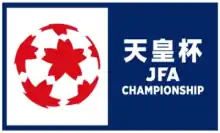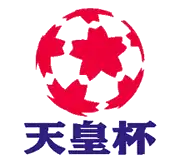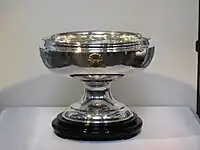 | |
| Founded | 1921 |
|---|---|
| Region | Japan |
| Number of teams | 88 |
| Qualifier for | AFC Champions League Elite |
| Current champions | Kawasaki Frontale (2nd title) |
| Most successful club(s) | Urawa Red Diamonds Keio BRB (8 titles each) |
| Television broadcasters | NHK (live matches) NHK (highlights) |
| Website | jfa.jp/emperorscup |

The Emperor's Cup JFA All-Japan Football Championship Tournament (Japanese: 天皇杯 JFA 全日本サッカー選手権大会, Hepburn: Tennōhai Jēefuē Zen-Nihon Sakkā Senshuken Taikai),[1][2] commonly known as The Emperor's Cup (Japanese: 天皇杯, サッカー天皇杯, Hepburn: Tennōhai, Sakkā Tennōhai) or Japan FA Cup, and rebranded as The JFA Emperor's Cup from 2024 onwards, is a Japanese football competition. It has the longest tradition of any football match in Japan, dating back to 1921, before the formation of the J.League, current JFL (not former JFL) and their predecessor, Japan Soccer League.
Before World War II, teams could qualify not only from Japan proper but also from Empire of Japan's former-colonies such as Korea, Taiwan, and sometimes Manchukuo. The winning club qualifies for the AFC Champions League and the Japanese Super Cup. The women's equivalent to this tournament is the Empress's Cup.
The current winners are Kawasaki Frontale, having won their second cup in 2023 edition and previously won their first in 2020.
Overview
As it is a competition to decide the "best soccer club in Japan", the cup is now open to every member club of the Japan Football Association, from J1 and J2 (J.League Divisions 1 and 2) down to teams from J3 (J3 League), JFL, regional leagues, and top college and high school teams from around the country. The Emperor's Cup is one of two well-known national football tournaments named after a monarch (the other is Spain's Copa del Rey).
The holder can wear a Yatagarasu emblem (the ordinary winner wears one, the E letter and the purple line above the bird, the league-cup double winner can wear the gold star and line above the Yatagarasu) and obtains an AFC Champions League spot for the next season.
Since the creation of the J.League in 1992, the professional teams have dominated the competition, although doubles, once common in the JSL, have become very rare. However, because the Emperor's Cup is contested in a knockout tournament format, the opportunity for "giant-killers" from the amateur ranks upsetting a top J.League squad is a very real possibility. For example, a major upset almost occurred in the 2003/04 competition, when Funabashi Municipal High School took the 2003 J.League champion Yokohama F. Marinos to a penalty shootout.[3] Waseda University was the last non-league winner in 1966, and the previous non-top tier winner was in 2011 (contested by two second-tier teams, FC Tokyo and Kyoto Sanga, with FC Tokyo winning 4–2).
Since 1969, the Emperor's Cup final had traditionally been played on New Year's Day of the following year at the National Stadium in Tokyo and is regarded as the traditional closing match of the season. Since 2014, the venue has varied due to the stadium's renovation for the 2020 Summer Olympics. The 2014 Emperor's Cup Final was not held on New Year's Day, but 13 December 2014, due to the Japan's qualification to the 2015 AFC Asian Cup. The 2018 final was held on 9 December 2018. Although an official reason has not been given, it was suspected due to the national team's involvement in 2019 AFC Asian Cup.
On 1 January 2020, first time finalist Vissel Kobe beat Kashima Antlers in the 2019 Emperor's Cup Final at the recently built new National Stadium to win the first title in their 54-year club history.[4] This was the first professional match in Japan video assistant referee (VAR) being used.[5]
Format
The first matches to qualify for the Emperor's cup begin anywhere from April to August of that year, and varies year to year. For the 97th Emperor's Cup (2017), the games were played from 22 April 2017 and ended with the final on 1 January 2018.[6] The knockout phase of the competition begins towards the end of the year. This phase is composed of all teams from J1 League (J1) and J2, the winners from each of the 47 prefectural championships (consist of amateur teams ranging from J3 League to college teams), and 1 organizer-nominated team among all amateur teams (this was assigned to the collegiate champion until 2011).
J1 teams, and sometimes J2 team(s) also receive bye(s) in the knockout phase. In 2016, all J1 teams and the previous year's J2 champions received a bye, and AFC Champions League participants received 3 byes. In 2017, all J1 and J2 teams received a bye. However, they lose home advantage starting from the third round, unless they are facing a higher-tier or higher ranked team.
From 1965 to 1971, the top 4 JSL clubs at the end of the season qualified for the Cup and the other four spaces allotted were taken by finalists from universities. From 1972 to 1995, as the League increased in size, the entire top division teams were entered automatically, while the second tier's member clubs participated in regional stages with other clubs. Beginning in 1996, the second-tier clubs (at the time, the old Japan Football League) began to be admitted automatically instead of having to play regional stages, which in turn became prefectural stages.
Before 2008, 48 teams took part in the first two rounds – the winner from each of the 47 prefectural championships and the collegiate champion. The top team in the JFL standings and all thirteen J2 teams joined in the third round. Finally, the eighteen J1 teams joined in the fourth round, making a total of 80 participating teams.
Trophy

The original All Japan Championship Tournament trophy was awarded to the JFA by the English Football Association in 1919. This trophy was used until January 1945, when the militarist government confiscated it and melted down to procure additional metal for the war effort.[7] When the tournament was reinstated, the present trophy, showing the Imperial chrysanthemum seal began to be awarded.
In August 2011, the English FA presented its Japanese counterpart with a replica of the original trophy, made by London silversmiths Thomas Lyte.[8] JFA President Junji Ogura expressed hope that the trophy, to be awarded at the 2011 final, would be "a symbol of peace".[9][7]
Qualification to AFC Champions League

The cup winner qualifies for the AFC Champions League (ACL) since the 2001 tournament, where Shimizu S-Pulse qualified for the ACL 2002–03. Before the establishment of ACL, the cup winner qualified for the Asian Cup Winners' Cup. From 2012, as a part of the requirement of AFC, the champion team must also hold a J1 Club License in order to enter the ACL (but not necessary to be a Division 1/J1 team).
From the 2002–03 to 2008 ACL editions, the cup winner participated in the ACL that began one year later; for example, the Emperor's Cup winner for the 2005 season (crowned on 1 January 2006) participated in the 2007 tournament. In November 2007, the JFA announced that the 2009 ACL spot would be given to the 2008 season's winner (crowned on 1 January 2009), not the 2007 winner. As a result, the 2007 winner, Kashima Antlers, did not earn the 2009 ACL spot through the championship. (Nevertheless, Antlers eventually earned the 2009 ACL spot by winning the 2008 J.League Division 1.)
With the reform of AFC Club Competitions starting from the 2024–25 season, the champions will be qualified for the brand-new top tier tournament named AFC Champions League Elite, and they will be seeded into the League stage of that tournament.
If the cup winner has already earned an AFC Champions League spot through finishing above third in J1 League, the last spot will be given to J1's fourth-placed team.
List of Emperor's Cup finals
Teams in bold indicate doubles with the league title, while teams in italics indicate non-top flight clubs (both after 1965).
Performances
All-time
- University club's performance separated as follows: Players are enrolled students / Players are enrolled students and graduates.
| Club | Winners | Runners-up | Winning seasons | Runners-up seasons |
|---|---|---|---|---|
| Urawa Red Diamonds | 8 | 4 | 1971, 1973, 1978, 1980, 2005, 2006, 2018, 2021 | 1967, 1968, 1979, 2015 |
| Keio BRB (Enrolled students and graduates) | 8 | 2 | 1932, 1936, 1939, 1940, 1951, 1952, 1954, 1956 | 1930, 1960 |
| Yokohama F. Marinos | 7 | 2 | 1983, 1985, 1988, 1989, 1991, 1992, 2013 | 1990, 2017 |
| Kwansei Gakuin University | 7 | 0 | 1929, 1930, 1950, 1953, 1955, 1958, 1959 | |
| Tokyo Verdy | 5 | 3 | 1984, 1986, 1987, 1996, 2004 | 1981, 1991, 1992 |
| Gamba Osaka | 5 | 3 | 1990, 2008, 2009,2014, 2015 | 2006, 2012, 2020 |
| Kashima Antlers | 5 | 3 | 1997, 2000, 2007, 2010, 2016 | 1993, 2002, 2019 |
| Cerezo Osaka | 4 | 8 | 1968, 1970, 1974, 2017 | 1971,1972, 1976, 1977, 1983, 1994, 2001, 2003 |
| JEF United Chiba | 4 | 2 | 1960, 1961, 1964, 1976 | 1962, 1984 |
| Sanfrecce Hiroshima | 3 | 12 | 1965, 1967, 1969 | 1954, 1957, 1966, 1970, 1978, 1987, 1995, 1996, 1999, 2007, 2013, 2022 |
| Kashiwa Reysol | 3 | 4 | 1972, 1975, 2012 | 1963, 1973, 2008, 2023 |
| Shonan Bellmare | 3 | 4 | 1977, 1979, 1994 | 1975, 1982, 1985, 1988 |
| Imperial Univ. of Tokyo LB | 3 | 1 | 1931, 1946, 1949 | 1925 |
| Waseda University | 3 | 1 | 1938, 1963, 1966 | 1939 |
| Júbilo Iwata | 2 | 2 | 1982, 2003 | 1989, 2004 |
| Rijo Shukyu Football Club (Hiroshima) | 2 | 1 | 1924, 1925 | 1927 |
| Yokohama Flügels | 2 | 1 | 1993, 1998 | 1997 |
| Nagoya Grampus | 2 | 1 | 1995, 1999 | 2009 |
| Kawasaki Frontale | 2 | 1 | 2020, 2023 | 2016 |
| Shimizu S-Pulse | 1 | 4 | 2001 | 1998, 2000, 2005, 2010 |
| Yawata Steel | 1 | 3 | 1964 | 1956, 1958, 1965 |
| Keio University (Enrolled students) | 1 | 2 | 1937 | 1938, 1950 |
| Chuo University | 1 | 2 | 1962 | 1959, 1961 |
| Waseda University WMW | 1 | 1 | 1928 | 1940 |
| Chuo University Club | 1 | 1 | 1957 | 1955 |
| Nagoya Shukyu-dan | 1 | 1 | 1922 | 1923 |
| Nippon Kokan | 1 | 1 | 1981 | 1986 |
| Kyoto Sanga | 1 | 1 | 2002 | 2011 |
| Tokyo Shukyu-dan | 1 | 0 | 1921 | |
| Astra Club (Tokyo) | 1 | 0 | 1923 | |
| Kobe-Ichi Junior High School Club | 1 | 0 | 1927 | |
| Tokyo Old Boys Club | 1 | 0 | 1933 | |
| Kyungsung FC | 1 | 0 | 1935 | |
| FC Tokyo | 1 | 0 | 2011 | |
| Vissel Kobe | 1 | 0 | 2019 | |
| Ventforet Kofu | 1 | 0 | 2022 | |
| Osaka Club | 0 | 3 | 1951, 1952, 1953 | |
| Kobe University of Commerce | 0 | 2 | 1937, 1946 | |
| Mikage Shukyu-dan (Kobe) | 0 | 1 | 1921 | |
| Hiroshima Koto-shihan | 0 | 1 | 1922 | |
| All Mikage Shihan Club (Kobe) | 0 | 1 | 1924 | |
| Imperial University of Kyoto | 0 | 1 | 1928 | |
| Hosei University | 0 | 1 | 1929 | |
| Kobun Junior High School (Taiwan) | 0 | 1 | 1931 | |
| Yoshino Club (Nagoya) | 0 | 1 | 1932 | |
| Sendai Soccer Club | 0 | 1 | 1933 | |
| Tokyo Bunri University | 0 | 1 | 1935 | |
| Bosung College (Seoul) | 0 | 1 | 1936 | |
| Kandai Club | 0 | 1 | 1949 | |
| Rikkyo University | 0 | 1 | 1969 | |
| Eidai Industries | 0 | 1 | 1974 | |
| Tanabe Pharmaceutical | 0 | 1 | 1980 | |
| Montedio Yamagata | 0 | 1 | 2014 | |
| Vegalta Sendai | 0 | 1 | 2018 | |
| Oita Trinita | 0 | 1 | 2021 |
J.League era (1992–present)
| Club | Winners | Runners-up | Winning seasons | Runners-up seasons |
|---|---|---|---|---|
| Kashima Antlers | 5 | 3 | 1997, 2000, 2007, 2010, 2016 | 1993, 2002, 2019 |
| Gamba Osaka | 4 | 3 | 2008, 2009, 2014, 2015 | 2006, 2012, 2020 |
| Urawa Red Diamonds | 4 | 1 | 2005, 2006, 2018, 2021 | 2015 |
| Yokohama F. Marinos | 2 | 1 | 1992, 2013 | 2017 |
| Yokohama Flügels | 2 | 1 | 1993, 1998 | 1997 |
| Nagoya Grampus | 2 | 1 | 1995, 1999 | 2009 |
| Tokyo Verdy | 2 | 1 | 1996, 2004 | 1992 |
| Kawasaki Frontale | 2 | 1 | 2020, 2023 | 2016 |
| Shimizu S-Pulse | 1 | 4 | 2001 | 1998, 2000, 2005, 2010 |
| Cerezo Osaka | 1 | 3 | 2017 | 1994, 2001, 2003 |
| Kashiwa Reysol | 1 | 2 | 2012 | 2008, 2023 |
| Kyoto Sanga | 1 | 1 | 2002 | 2011 |
| Júbilo Iwata | 1 | 1 | 2003 | 2004 |
| Shonan Bellmare | 1 | 0 | 1994 | |
| FC Tokyo | 1 | 0 | 2011 | |
| Vissel Kobe | 1 | 0 | 2019 | |
| Ventforet Kofu | 1 | 0 | 2022 | |
| Sanfrecce Hiroshima | 0 | 6 | 1995, 1996, 1999, 2007, 2013, 2022 | |
| Montedio Yamagata | 0 | 1 | 2014 | |
| Vegalta Sendai | 0 | 1 | 2018 | |
| Oita Trinita | 0 | 1 | 2021 |
Other Emperor's Cups
The Emperor's Cup term is used for many national championships in other sports, including judo (the All-Japan Judo Championships) and volleyball (Emperor's Cup and Empress's Cup All Japan Volleyball Championship). The Emperor's Cup (天皇賜杯, Tennō shihai) is awarded to the top division yūshō winner of a sumo tournament.[11]
See also
- Football in Japan
- Japan Football Association (JFA)
- Japanese association football league system
- League system
- J.League
- Japan Football League (JFL) (IV)
- Japan Regional Football Champions League (Promotion Play-offs to JFL)
- Japanese Regional Leagues (V/VI)
- Fujifilm Super Cup (Super Cup)
- J.League YBC Levain Cup (League Cup)
- Empress's Cup
References
- ↑ The logo used in Japan is labeled 「天皇杯 JFA CHAMPIONSHIP」or「天皇杯」.
- ↑ "Emperor's Cup JFA 101st Japan Football Championship TOP". Japan Football Association (in Japanese). Archived from the original on 20 December 2021. Retrieved 20 December 2021.
- ↑ "2003 Japan Football Season Review". Archived from the original on 26 October 2005. Retrieved 21 May 2006.
- ↑ "AFCチャンピオンズリーグ2020 ヴィッセル神戸が本大会の出場権を獲得" (in Japanese). Japan Football Association. 1 January 2020. Archived from the original on 1 January 2020. Retrieved 1 January 2020.
- ↑ "第99回天皇杯 決勝でビデオアシスタントレフェリー(VAR)を導入" (in Japanese). Japan Football Association. 14 November 2019. Archived from the original on 1 January 2020. Retrieved 1 January 2020.
- ↑ "第97回天皇杯全日本サッカー選手権大会". JFA.jp. Archived from the original on 18 January 2018. Retrieved 10 January 2018.
- 1 2 "England replaces football trophy Japan melted down during Second World War". The Telegraph. 7 September 2011. Archived from the original on 12 January 2022.
- ↑ "FA Gives Japan New Cup". Acumen. British Chamber of Commerce in Japan. October 2011.
- ↑ "F.A. Silver Cup to be presented to Emperor's Cup winners". Japan Football Association. 29 August 2011. Archived from the original on 16 May 2012. Retrieved 9 September 2011.
- ↑ "サッカー日本一を決める最大のトーナメント 第92回天皇杯全日本サッカー選手権大会、9月1日(土)いよいよ開幕!" [The largest tournament in Japan for the championship – The 92nd Emperor's Cup All-Japan Soccer Championship begins on September 1]. Japan Football Association. 31 August 2012. Archived from the original on 3 March 2016. Retrieved 3 March 2016.
- ↑ "Sumo Emperor Cup". The Japan Times. 12 September 2018. Archived from the original on 24 September 2020.
External links
- Official website, JFA.jp (in English)
- RSSSF.com - Japan - List of Emperor's Cup Finals